
We live in an age of tremendous human activity and are losing the fight to save biodiversity. True wilderness is almost non-existent and habitat loss has caused 30 percent of the world’s species to be on the brink of extinction; many more will be permanently lost within our lifetimes. Due to a heightened awareness of the earth’s fragility, many of us feel helpless and hopeless over the human-induced destruction of the earth’s flora and fauna. But having knowledge of what we do wrong enables us to make things right: In our own private yards we can create a little piece of the world we want to live in.
The basic principle behind eco-functional or naturalistic gardening is for humans to live successfully as part of an ecosystem, instead of separate from it. Of all the species in the world, we have the ability of create of our own volition: We may choose to exploit the land, harm its vulnerable creatures, and exhaust resources just because we can, without asking whether we should. Or we can choose to enhance and protect, so that the beauty, function, diversity, and structure of the ecosystem is maintained and balanced. In plain terms, we need to balance our taking with giving back.
Eco-functional gardening can provide for our needs without harming others. It is a simple, often inexpensive activity that also gives us a feeling of well-being and self-sufficiency. Although we won’t be able to perfectly recreate a historic landscape, natural site conditions can be replicated approximately using plants indigenous to the area. Lawn can be removed or minimized and synthetic fertilizers, pesticides, and nonrenewable substances (like peat) can be avoided.
As stewards of nature, we can have year round, ecologically beneficial gardens that thrive with healthy soil, support a diverse population of native plants and wildlife, provide us with food, and look gorgeous. Whether you’re starting with a bulldozed suburban lot or a tiny urban courtyard, a garden will be most sustainable when we mimic nature and add garden elements that are well-suited to the site and surrounding area. Hardly new, guidelines for sustainable gardening are found in many schools, including organic, English cottage, permaculture, bio-dynamic, and Arts & Crafts gardening.
